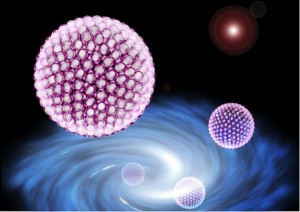
Light Triggered Spontaneous Assembly of Nanoparticles to Nanovesicles
Jun 18, 2014 Email"> PrintText Size


New methods to nanovesicles: light triggered spontaneous assembly of inorganic nanoparticles (Image by Tierui Zhang)
The self-assembly of inorganic nanoparticles (NPs) is an attractive strategy to design and fabricate new well-defined functional nanoarchitectures. Among which, nanovesicles have drawn great attentions in a broad range of applications including catalysis, sensors, bioimaging, and drug delivery due to their hollow structures and collective properties of NPs. Currently, other from templated assembly of inorganic NPs at the interfaces, such vesicles can also be assembled in homogeneous solvents with the help of amphiphilic polymers. However, these vesicles are usually at the size larger than 100 nm, which obviously restricts their applications in biomedication, and so on.Recently, a team led by Prof. Tierui Zhang at the Technical Institute of Physics and Chemistry, CAS (China), Prof. Zhiyong Tang at the National Center of Nanoscience (China) and Prof. Zhihong Nie at University of Maryland (US) reported a novel and versatile strategy to assemble inorganic NPs into sub-50 nm vesicles with single or multiple layers of NPs in the membranes under UV light irradiation. This new approach is very attractive for preparing vesicular structures since light is non-invasive and controllable in both time and space. Better still, unlike commonly used sophisticated photo-responsive ligands, this strategy is based on the photo-oxidation of simple and commercial thiol ligands modified to the surface of NPs. Moreover, the authors also demonstrated that this strategy is versatile to assemble a variety of metal and semiconductor NPs, including Au NPs, Pd NPs, Pt NPs and CdSe quantum dots (QDs), into nanovesicles.Thanks to the unique porous, hollow and macroscopic structural features, nanovesicles assembled from NPs have significant advantages over individual NPs for many applications. Remarkably, when used in solar-driven hydrogen production, the as-prepared CdSe QD vesicles exhibit not only an improved catalytic activity but also an unprecedented catalytic stability compared with current popularly-used individual QDs. The reason for improved catalytic performances can be attributed to the higher efficiency light harvest of vesicular catalysts and their much more stable structures.In conclusion, this work not only provides a deep understanding of externally-triggered assembly of NPs into hierarchical and functional nanoarchitectures, but also creates numerous new opportunities for catalysis, bioimaging, drug delivery, and therapy applications. (Source: MaterialsViews staff )

New methods to nanovesicles: light triggered spontaneous assembly of inorganic nanoparticles (Image by Tierui Zhang)
The self-assembly of inorganic nanoparticles (NPs) is an attractive strategy to design and fabricate new well-defined functional nanoarchitectures. Among which, nanovesicles have drawn great attentions in a broad range of applications including catalysis, sensors, bioimaging, and drug delivery due to their hollow structures and collective properties of NPs. Currently, other from templated assembly of inorganic NPs at the interfaces, such vesicles can also be assembled in homogeneous solvents with the help of amphiphilic polymers. However, these vesicles are usually at the size larger than 100 nm, which obviously restricts their applications in biomedication, and so on.
Recently, a team led by Prof. Tierui Zhang at the Technical Institute of Physics and Chemistry, CAS (China), Prof. Zhiyong Tang at the National Center of Nanoscience (China) and Prof. Zhihong Nie at University of Maryland (US) reported a novel and versatile strategy to assemble inorganic NPs into sub-50 nm vesicles with single or multiple layers of NPs in the membranes under UV light irradiation.
This new approach is very attractive for preparing vesicular structures since light is non-invasive and controllable in both time and space. Better still, unlike commonly used sophisticated photo-responsive ligands, this strategy is based on the photo-oxidation of simple and commercial thiol ligands modified to the surface of NPs. Moreover, the authors also demonstrated that this strategy is versatile to assemble a variety of metal and semiconductor NPs, including Au NPs, Pd NPs, Pt NPs and CdSe quantum dots (QDs), into nanovesicles.
Thanks to the unique porous, hollow and macroscopic structural features, nanovesicles assembled from NPs have significant advantages over individual NPs for many applications. Remarkably, when used in solar-driven hydrogen production, the as-prepared CdSe QD vesicles exhibit not only an improved catalytic activity but also an unprecedented catalytic stability compared with current popularly-used individual QDs. The reason for improved catalytic performances can be attributed to the higher efficiency light harvest of vesicular catalysts and their much more stable structures.
In conclusion, this work not only provides a deep understanding of externally-triggered assembly of NPs into hierarchical and functional nanoarchitectures, but also creates numerous new opportunities for catalysis, bioimaging, drug delivery, and therapy applications. (Source: MaterialsViews staff )
CAS Institutes
There are 124 Institutions directly under the CAS by the end of 2012, with 104 research institutes, five universities & supporting organizations, 12 management organizations that consist of the headquarters and branches, and three other units. Moreover, there are 25 legal entities affiliated and 22 CAS invested holding enterprisesThere are 124 I...>> more
Contact Us

Chinese Academy of Sciences
Add: 52 Sanlihe Rd., Xicheng District, Beijing, China
Postcode: 100864
Tel: 86-10-68597592 (day) 86-10-68597289 (night)
Fax: 86-10-68511095 (day) 86-10-68512458 (night)
E-mail: cas_en@cas.cn

